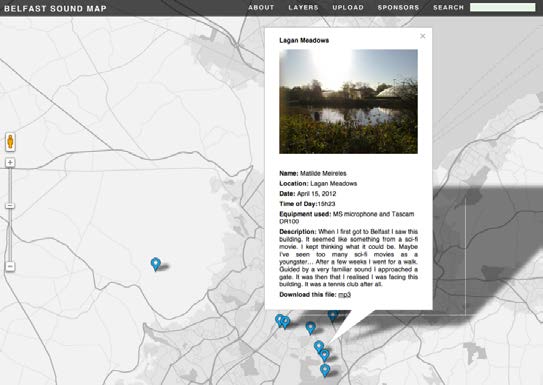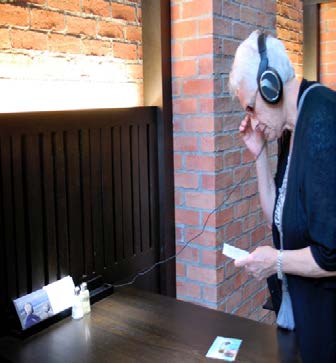Sounds of the City: Engaging Communities in Sonic Arts
Submitting Institution
Queen's University BelfastUnit of Assessment
Music, Drama, Dance and Performing ArtsSummary Impact Type
CulturalResearch Subject Area(s)
Studies In Human Society: Human Geography
Language, Communication and Culture: Cultural Studies
History and Archaeology: Curatorial and Related Studies
Summary of the impact
This case study demonstrates how new approaches to collaborative sonic
arts lead to
increased awareness of the role of sound and its relationship to place in
everyday life. This new
understanding of the aural world resulted in the preservation and
presentation of past and
present cultural heritage specific to two intergenerational participating
communities. The impact
of the research is specifically articulated through a community project
and exhibition entitled
"Sounds of the City" commissioned by the new Metropolitan Arts Centre
(Belfast) and funded
by the Heritage Lottery Fund in 2012.
Underpinning research

The impact associated with Sounds of
the City draws on soundscape
research conducted at the Sonic Arts
Research Centre (SARC) since its
inception in 2004; in particular through
work concerned with the role of sound
in everyday experience. The
underpinning body of research
employs multiple methodologies to
address cultural, aesthetic and social
aspects of sound in its relation to
memory, place and community. The
core research that underpins this
impact focuses on the following
questions: How can sound help
articulate an experience of place and
everyday life? How can the notion of evocative listening be promoted in
the context of sound
art? How participatory community engagement encourage sharing of
experiences through
sound?
The research falls under two categories; the Sounds of the City project
itself (led by
Professor Rebelo with PhD students Chaves, Meireles and McEvoy) and two
publications,
(Chaves, Rebelo 2012) and (Rebelo, Green, Hollerweger, 2008) outlining
theoretical
frameworks that informed the exhibition. "Sounds of the City" is a
large-scale community
project and exhibition commissioned by the £18m Metropolitan Arts Centre
(MAC) for its
opening in April 2012. Over a four-month period, the artists worked
together with two
intergenerational groups in Belfast with the aim of addressing specific
sound qualities of
places, events and stories. Themes that surfaced from this process
constitute the basis for
the exhibition which promotes listening as a form of intersecting daily
life, identity and
memory. Five installations address aural contexts ranging from Belfast's
industrial heritage
to the local family home. These are shaped by present and past experiences
of workshop
participants at Dee Street Community Centre in East Belfast and Tar
Isteach in North
Belfast. The materials for these installations centre upon the
relationship between sound
and memory, sound and place, and the documentation of everyday personal
auditory
experience.
The five installations include interactive sound environments based on
participant's
memories of shipyard workers returning home "The Walk Home", a
participative open
platform inviting Belfast's residents and visitors to contribute sounds to
the "Belfast Sound
Map", the use of image and text in "Five Places" based on the field
recording experiences of
five community participants, the use of interviews reflecting on the role
of sound in three
aspects of everyday life "Work / Home / Play" and a sound object rendering
an ubiquitous
sound of the past in "Call for Work".
The exhibition materials and their documentation (http://www.soundsofthecity.info)
constitute the
core underpinning research for the impact described here. The exhibition
was subsequently
selected by Invest Northern Ireland to represent Northern Ireland in a
state visit to Brazil by the
First Minister and Deputy First Minister. Presented by the British Embassy
at Espaço Ecco in
Brasilia (14 March — 14 April 2013) this event provided further
opportunities to articulate
impact through community visits and school visits engaging in the
gallery's outreach and
education programme.
Two other pieces of published research directly underpins the impact
described here:
The paper "Evocative Listening: Mediated practices in everyday life"
(Chaves, Rebelo 2012)
outlines how the use of technology can induce a sense of the evocative and
enrich the
relationship between individuals and their sound environment through
memories,
behaviours and cultural context. The paper further outlines creative works
exploring public
engagement in
sound art. The paper refers to work developed by three PhD students under
Rebelo's
supervision (Chaves, Hollerweger and Green) and provides a framework for
active listening
in
an everyday context. This work has been central to the development of both
workshops and
presentational strategies in Sounds of the City.
The article "A Typology for Listening in Place" (Rebelo, Green,
Hollerweger, 2008) provides a
theoretical framework for thinking about the listening strategies at play
in archetypal places
such as the theatre, museum and the city. Ideas of listening in place as
well as the relationship
between sound and location were further developed in Sounds of the City.
References to the research
Creative Practice:
Rebelo, P. Chaves, R. Meireles, M., McEvoy, A. (2012) Sounds of the City,
Exhibition at
the Metropolitan Arts Centre, Belfast, UK
Funded through the Metropolitan Arts Centre with a grant from the Heritage
Lottery Fund
(£20k)
Rebelo, P. Chaves, R. Meireles, M., McEvoy, A. (2013) Sounds of the City,
Exhibition at
the Espaço Ecco, Brasilia, Brazil
Funded by Northern Ireland Bureau, Invest Northern Ireland, British
Embassy Brasilia
and Queen's University Belfast
Peer Reviewed Publications
- Chaves, R. Rebelo, P. (2012). Evocative Listening: Mediated practices
in everyday
life, Organised Sound, 17
Research partly funded by a Gulbenkian Foundation PhD studentship
(2009-13, £60k)
- Rebelo, P. Green, M. Hollerweger, F. (2008) A Typology for Listening in
Place.Mobile
Music Workshop
Research partly funded by an EPSRC Case studentship sponsored by Hewlett
Packard
(2006-10, £60k)
Details of the impact
The impact of the research will be described in relation to participating
individuals
(intergenerational local communities in Sounds of the City), the public
visiting the exhibition
(over 60 000 during five months) and initiatives which will translate the
project's methodologies
and approaches to further exhibitions in different regions (Sounds of the
City in Brasilia and
Sounds of the City : Rio which will be taking place in 2014 with local
favela communities and in
collaboration with the Universidade Federal do Rio de Janeiro).

Beneficial impact for participating communities is focused on
raising awareness of sound in everyday life and hence
enriching cultural life. Connecting younger and older
individuals from opposite ends of the sectarian divide in
Northern Ireland in a collaborative project focusing on
Belfast as a city makes a contribution to reconciliation
through the sharing of experiences. The project also impacts
on the preservation of cultural heritage through sound and
presents it publically in a professional art context.
This impact was achieved by developing exhibition materials
through workshops, interviews and field-recording sessions
with community members. Workshops acted as a basis from
which to inform each group about the project's aims, methods
of listening, methods of documenting sound and the other topics relating
to soundscape studies
and acoustic ecology. They also provided a central point for allowing
participants to organize
outside activities and share materials for the exhibition. Participants
gained listening skills as well
as a vocabulary for describing listening experiences. The younger group of
participants benefited
from the acquisition of practical skills in sound recording and editing.
Written questionnaires completed by fifteen participants at the end of
the Belfast project
revealed that 93.33% felt that the project had increased their awareness
of sound. When
asked to rate the extent of their awareness of sound in everyday life
post-`Sounds of the City'
on a scale of 1-5 (5 representing maximum awareness 1 being minimum), the
survey
averaged at 3.733. The overwhelming use of positive language and
willingness to not only
engage but also to suggest a wide range of possible activities to take
place in the future,
point towards a positive experience of the project.
The exhibition in Brasilia benefited from widespread media presence,
including national TV
(Rede Globo) and was able to articulate further impact through, for
example, the visit by an
education centre for the visually impaired on 14th March 2013. This group
was able to
reflect on the experience of sound and place and expressed how the
exhibition acted as a
trigger for their own experiences: "I was able to identify the sounds that
I heard. They
reminded me of when I was a child in Minas Gerais and went to the
waterfalls" (Izabel
Gonalves Costa, 45 years old, blind), "Through sound we know where we
are", "I compared
the sound of city centres with remote places. I suggest you make some
recordings in São
Paulo. I used to live there and there is a great contrast between the
centre and the
periphery from this point of view." (Fernando Rodrigues, 36, blind from 6
years old).
From the point of view of internationalisation, the exhibition in Brasilia
performed a role in
terms of showcasing Belfast through the sonic arts (a relatively unknown
artform in Brazil)
from the perspective of local individual listening experience. The
international recognition of
the city of Belfast and its association with ground breaking sonic arts
practice is referred to in
speeches and letters by the First Minister, Deputy First Minister and
British Ambassador.
"When we look at our history we're having to look at postcards and old
photographs but this
tremendous initiative [...] to put this exhibition together where we have
sightseeing by sound
if I can put it that way to experience Belfast." (First Minister, Peter
Robinson)
"Going through the exhibition and seeing places that are familiar, sounds
that are familiar is a
very extraordinary experience." (Deputy First Minister, Martin McGuiness)
Wider impacts of the project include:
- innovative creative practice showcasing local everyday experiences in a
high
profile museum environment
- stimuli for positively engaging with the city through participation in
the ongoing
Belfast Sound Map project, now the focus of an AHRC Cultural Engagement
Grant
in
partnership with the Belfast City Council (Belfast Soundwalks)
- contribution to the international recognition of the city of Belfast
through the exhibition
in
Brasilia and related media coverage
The development of workshop methodologies which will be transferred to
other cultural contexts — Sounds of the City: Rio Maré 2014, at the Maré
Favela and in partnership with the Universidade Federal do Rio de Janeiro.
Sources to corroborate the impact
- Letter from the British Ambassador in Brasilia describing the
impact of the Sounds of
the City exhibition at Espaço Ecco in terms of showcasing Belfast's
identity through
innovative sonic arts — on file
- Transcript from speeches by Northern Ireland's First Minister and
Deputy First
Minister on the occasion of the opening of Sounds of the City in
Brasilia
(12.03.2013) — on file
- Testimonials from members of the Centro de Ensino Especial de
Deficientes Visuais
(Visually Impaired Education Centre in Brasilia) —on file Sounds of the
City 2012
participant questionnaires and analysis (Sonic Arts Research Centre) —
on file
Sounds of the City project website:http://www.soundsofthecity.info
Final Report to Lottery Heritage Funds (Metropolitan Arts Centre)